
A jug band is a band employing a jug player and a mix of conventional and homemade instruments. These homemade instruments are ordinary objects adapted to or modified for making sound, like the washtub bass, washboard, spoons, bones, stovepipe, jew's harp, and comb and tissue paper. The term jug band is loosely used in referring to ensembles that also incorporate homemade instruments but that are more accurately called skiffle bands, spasm bands, or juke bands because they do not include a jug player.
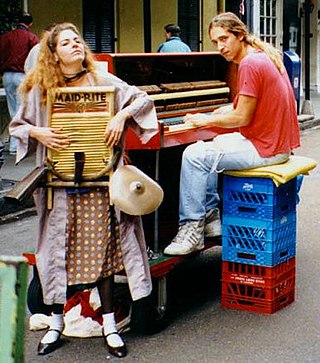
The washboard and frottoir are used as a percussion instrument, employing the ribbed metal surface of the cleaning device as a rhythm instrument. As traditionally used in jazz, zydeco, skiffle, jug band, and old-time music, the washboard remained in its wooden frame and is played primarily by tapping, but also scraping the washboard with thimbles. Often the washboard has additional traps, such as a wood block, a cowbell, and even small cymbals.
A slide whistle is a wind instrument consisting of a fipple like a recorder's and a tube with a piston in it. Thus it has an air reed like some woodwinds, but varies the pitch with a slide. The construction is rather like a bicycle pump. Because the air column is cylindrical and open at one end and closed at the other, it overblows the third harmonic. "A whistle made out of a long tube with a slide at one end. An ascending and descending glissando is produced by moving the slide back and forth while blowing into the mouthpiece." "Tubular whistle with a plunger unit in its column, approximately 12 inches long. The pitch is changed by moving the slide plunger in and out, producing ascending and descending glisses."
Skiffle is a genre of folk music with influences from American folk music, blues, country, bluegrass, and jazz, generally performed with a mixture of manufactured and homemade or improvised instruments. Originating as a form in the United States in the first half of the 20th century, it became extremely popular in the United Kingdom in the 1950s, where it was played by such artists as Lonnie Donegan, the Vipers Skiffle Group, Ken Colyer, and Chas McDevitt. Skiffle was a major part of the early careers of some musicians who later became prominent jazz, pop, blues, folk, and rock performers, the Quarrymen and Rory Gallagher among them. It has been seen as a critical stepping stone to the second British folk revival, the British blues boom, and the British Invasion of American popular music.

Lindley Armstrong "Spike" Jones was an American musician, bandleader and conductor specializing in spoof arrangements of popular songs and classical music. Ballads receiving the Jones treatment were punctuated with gunshots, whistles, cowbells, hiccups, burps, and outlandish and comedic vocals. Jones and his band recorded under the title Spike Jones and His City Slickers from the early 1940s to the mid-1950s, and they toured the United States and Canada as "The Musical Depreciation Revue".
The New Vaudeville Band was a group created by songwriter Geoff Stephens in 1966 to record his novelty composition "Winchester Cathedral", a song inspired by the dance bands of the 1920s and a Rudy Vallée megaphone-style vocal. To his surprise, the song became a transatlantic hit that autumn, reaching the Top 10 in the United Kingdom and rising to No. 1 in the United States. The New Vaudeville Band initially was a studio group composed of session players, but Stephens quickly assembled a permanent group to continue recording and to play live shows. The group has been periodically revived since, without Stephens' participation.
Captain Stubby and the Buccaneers was a country-comedy band that performed largely in the Midwest United States from the late 1930s into the 1960s.
The Memphis Jug Band was an American musical group active from the mid-1920s to the late-1950s. The band featured harmonica, kazoo, fiddle and mandolin or banjolin, backed by guitar, piano, washboard, washtub bass and jug. They played slow blues, pop songs, humorous songs and upbeat dance numbers with jazz and string band flavors. The band made the first commercial recordings in Memphis, Tennessee, and recorded more sides than any other prewar jug band.
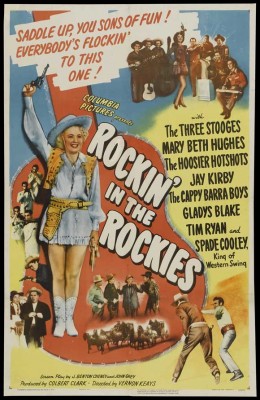
Rockin' in the Rockies is a 1945 American musical western feature film starring the Three Stooges. The picture was one of the Stooges' few feature-length films made during the run of their better-known series of short subjects for Columbia Pictures, although the group had appeared in supporting roles in other features. It is the only Stooges feature-length film with the team's best known line-up in starring roles.
Jackie Ward, better known as Robin Ward, is an American singer, regarded as a "one-hit wonder" of 1963 million-selling song "Wonderful Summer". However, using her real name she was highly accomplished and successful singing in groups. Ward's voice is heard in U.S. television series, motion pictures, advertisements, and pop records. She is one of the real singers of the hits attributed to The Partridge Family.
Joe Daniels, was a British Dixieland drummer and performer, whose career began in the early 1920s. Among his more popular numbers was "Experiments with Mice".

Hoosier Holiday is a 1943 American comedy film directed by Frank McDonald and written by Dorrell McGowan and Stuart E. McGowan. The film stars George D. Hay, Isabel Randolph, Shug Fisher, Lillian Randolph, Dale Evans and George Byron. The film was released on September 13, 1943, by Republic Pictures.

Hank Fisher, more commonly known as Washboard Hank is a Canadian musician, songwriter and stage performer. He was born in Peterborough, Ontario in 1954. He plays a number of instruments, including banjo, guitar and percussion. He is known for his unusual performances with self-created instruments. In 2016 he performed with his band, the Wringers.
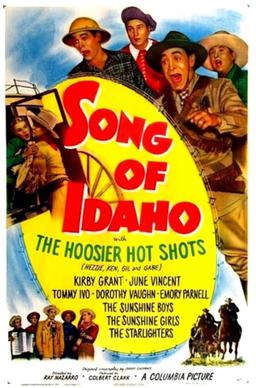
Song of Idaho is a 1948 American Western musical film directed by Ray Nazarro. It was released by Columbia Pictures.
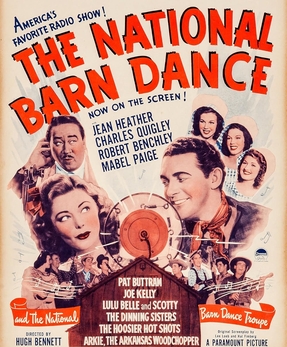
The National Barn Dance is a 1944 American comedy film directed by Hugh Bennett and written by Lee Loeb and Hal Fimberg. The film stars Jean Heather, Charles Quigley, Robert Benchley, Mabel Paige, Charles Dingle and Pat Buttram. The film was released on September 24, 1944, by Paramount Pictures.

Lone Star Moonlight is a 1946 American Western film directed by Ray Nazarro and written by Louise Rousseau. The film stars Ken Curtis, Joan Barton, Guy Kibbee, Robert Kellard, Claudia Drake and Arthur Loft. It was released on December 12, 1946 by Columbia Pictures.

Over the Santa Fe Trail is a 1947 American Western film directed by Ray Nazarro and written by Louise Rousseau. The film stars Ken Curtis, Jennifer Holt, Guy Kibbee, Guinn "Big Boy" Williams, Noel Neill and Holmes Herbert. The film was released on February 13, 1947, by Columbia Pictures.

Smoky River Serenade is a 1947 American Western film directed by Derwin Abrahams and written by Barry Shipman. The film stars Paul Campbell, Ruth Terry, Guinn "Big Boy" Williams, Virginia Hunter, Carolina Cotton and Cottonseed Clark. The film was released on August 21, 1947, by Columbia Pictures.
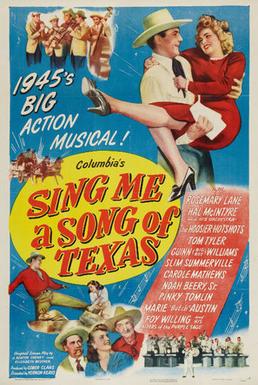
Sing Me a Song of Texas is a 1945 American Western film directed by Vernon Keays and written by J. Benton Cheney and Elizabeth Beecher. The film stars Rosemary Lane, Tom Tyler, Guinn "Big Boy" Williams, Slim Summerville, Carole Mathews, Noah Beery Sr., Pinky Tomlin and Marie Austin. The film was released on February 8, 1945, by Columbia Pictures. The film features Noah Beery Sr.'s final role in a motion picture.
Harold James O'Halloran was an American radio announcer and a singer.












